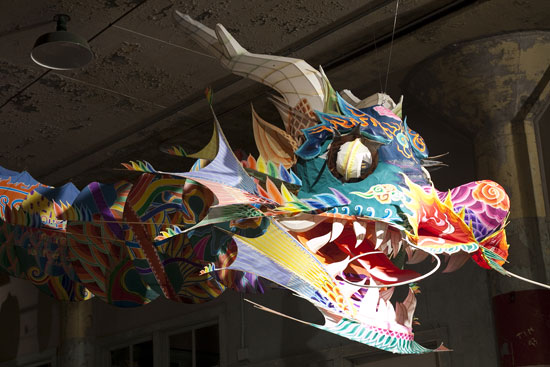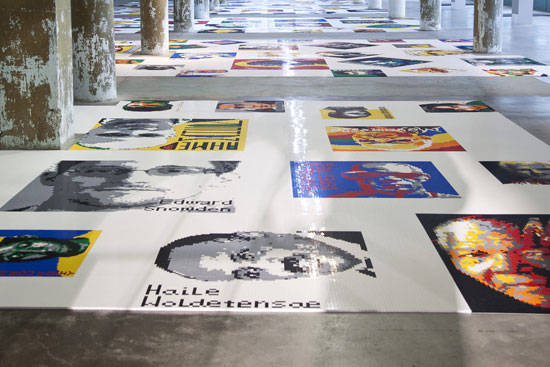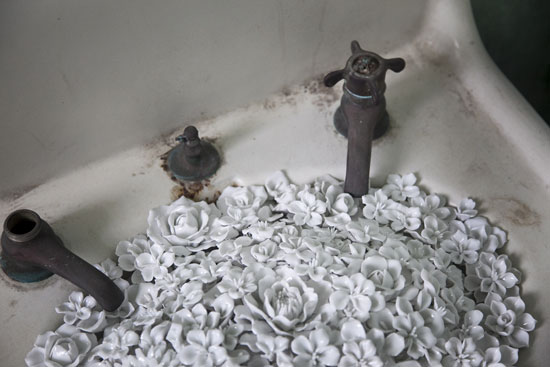On my first day in San Francisco, I was under starter’s orders from my art-aholic hostess Candy Caldwell: As soon as the plane lands at SFO, hustle to the Embarcadero in time for the last ferry to Alcatraz. Do not pass the Golden Gate Bridge or smash a crab on Fisherman’s Wharf. No cocktail at the Top of the Mark overlooking Nob Hill. I didn’t even get my one phone call. I was heading straight to prison.
The reason for the rush was a precious reservation to visit “@Large: Ai Weiwei on Alcatraz,” the Chinese artist’s unquestionably historic, yet decidedly problematic, installation at the legendary former prison. The work occupies an astonishing proportion of the island’s choice interior spaces thanks to the National Parks Service. Given the embattled Ai’s outsize reputation as the world’s most recognized dissident artist and the magnetically morbid attraction of the Rock, as the prison is known, as a tourist destination, I was only too happy to break in to jail.
The tour had a rocky start. In the New Industries building, where the prisoners worked including on a laundry for the military, Ai has suspended an overly cheerful, multi-hued dragon with circular quotations by Edward Snowden, Nelson Mandela and others. This part of the exhibit, titled With Wind, along with the adjoining room nearly covered in Lego tile portraits of political prisoners struck me as too lightweight by half – invoking a Chinese cliché that plays the fake, cheerful colors in a forced counterpoint to the drab, gray concrete of the surroundings, effectively fighting the space.
"The dragon in the old times, classically, is symbolic of the emperor, but we use that image to represent personal freedom. We think everybody has this personal power," the artist intones in the official video. "We want it to feel light, cheerful, full of energy and a lot of hope—even with joy. But it still reflects the will of this prisoner."
.

"With Wind" by Ai Weiwei, 2014. (installation detail, New Industries Building, Alcatraz). Photo: Jan Stürmann, courtesy FOR-SITE Foundation.
.
The pupils of the dragon are decorated with the shape of Twitter birds, a detail every guide seems tickled to point out. I thought it was a cheap trick, especially as the company’s sleek, giant headquarters are just down the freeway and profits were up, at a social media outlet in frequent use by ISIS to recruit fresh jihadists.
In China this pandering to power is called pai ma pi, the shameless cozening of a big shot or official, literally patting the ass of his horse in a self-serving gesture. It is beneath the dignity of an artist who earned his credibility as a provocateur and professional pain in the ass.
The exhibition of Lego portraits of Chinese dissidents, including some of the instigators of the petition Charter 08 as well as Li Wangyang, Xu Zhiyong, Li Bifeng, Zhu Yufu, Wang Bingzhang and others whose one-paragraph biographies are in a set of binders by their sector, seemed on more solid ground politically than the terrorists on the list of incarcerated political prisoners.
“There are some pretty bad guys in here,” remarked one sharp viewer glancing through the names of terrorists in custody. It is naïve to assert that all political prisoners are innocent. Because he is the son of a famous Modernist poet, Ai Qing, and because freedom of expression has been even further curtailed since the Tang dynasty when the greater poet Li Bai could barely get away with teasing the emperor’s courtesan for being a plump little bird (thinly disguised code for prostitute), and because the four-tone system of Mandarin is so amenable to punning, one has to be on the alert to word play whenever Ai Wei Wei is in the house.
The subtitle of the Lego portrait section is Trace in English, but the Chinese, zhui zong, is vastly more resonant, implying as it does the tracking of a thief as well as the leaving of a mark, zong ji, so that even the title “@Large,” poignant given Ai’s house arrest, implies deng lu or setting foot on a coastline, making it to California soil. Instead of saying one is “at large” or on the loose, in Chinese one uses deng lu to declare that a released or escaped prisoner “finds safe haven.”
.

"Trace" by Ai Weiwei, 2014. (Installation detail, New Industries Building, Alcatraz). Photo: Jan Stürmann, courtesy FOR-SITE Foundation.
.
Where Ai Wei Wei’s installation rises to meet the challenge of the site is the section called Refraction, viewed from the gun gallery (complete with shattered glass windows, among the most effective sculptural elements at hand). Panels originally used to focus the sun for cooking in Tibet are assembled in a giant wing of steel blades trapped in the sunlit room, a presence that has the monumental grandeur of similar wings by Anselm Kiefer.
The exhibition remains on this high level in the cell block, where the murmur of confused voices is heard from outside the cells. Words and music from tracks by such artists as the jailed Tibetan singer Lolo, Russia’s Pussy Riot, the Robben Island Singers and dissident poets, can be listened to clearly inside the cell, where the visitor sits on a small steel stool.
In the medical wing, little white ceramic flowers in the toilet bowls and sinks allude to Mao’s declaration in 1956, “Let a hundred flowers bloom, let a hundred schools of thought contend” (bai hua qi fang/bai jia zheng ming) one of those lovely poetic lies the Communists perfected to lure intellectuals into their clutches (including Ai’s dad, who emerged only to face a crackdown against rightists).
Today the equivalent is the state-sanctioned art show, performance or translation: ruses that put a smile on prosecutors’ faces even as they raise tax and bribe revenues for local government officials in China. By this time, the emotional as well as artistic tone has reached a level worthy of Ai Wei Wei’s reputation, and visitors will likely be ready to excuse some of the misfires.
Ai issues the challenge: “Any artist who isn’t an activist is a dead artist.” The wing, ceramic flowers and superb sound installation confirm that he is both artist and activist when he brings his A game.
.

"Stay Tuned" by Ai Weiwei, 2014. (Installation detail, A Block, Alcatraz). Photo: Jan Stürmann, courtesy FOR-SITE Foundation.
.

"Blossom" by Ai Weiwei, 2014. (Installation detail, Alcatraz Hospital). Photo: Jan Stürmann, courtesy FOR-SITE Foundation.
.
Major thought is demanded in an installation this loaded. The questions as well as answers need to measure up to the history of the site. Art that meets place, even landscape painting when the mirror of mimesis was the test, has to strike its own balance. Recognizing this, Stieglitz called his nature studies “equivalents.” The work need not always be elegy or monument, just demonstrate a sophisticated and sensitive historical awareness.
A former convict and famous current detainee under house arrest, Ai never visited Alcatraz, and at times I sensed this as a disadvantage, leaving the art and site intermittently out of tune.
The impressive guides to the installation were from the nonprofit that sponsored the work, the For-Site Foundation, whose founding executive director Cheryl Haines deserves co-authorship credit for @Large. The guides included a number of artists whose work is similarly site-specific, many of them environmentalists, and they were thoughtful and immensely cooperative when peppered with questions about the obstacles Ai faced.
Other artists occupy this kind of on-site space brilliantly, including Rachel Whiteread—my favorite is in Vienna—and Doris Salcedo, whose strong work can be found in many locations. Some artists take their shots and miss: one example is Ai’s contemporary, the usually brilliant Xu Bing, who offered an unimpressive but giant hanging phoenix kite suspended in the nave of the Cathedral of St. John the Divine that played many of the same chromatic tricks as the dragon at Alcatraz. Fortunately, in my view, this piece is no longer in place.
Certainly the prettiest sight during my first San Francisco trip was The Bay Lights, Leo Villareal’s twinkling, 25,000 LED white light sculpture illuminating the Bay Bridge for its 75th birthday. Elsewhere, on the basis of a deeply moving installation in Berlin not long ago, I am looking forward to the tragic idiom of Bettina WitteVeen, who takes over the abandoned hospital at the Brooklyn Navy Yard this coming September for a huge work titled “We Were Soldiers Once and Young.”
Ai Wei Wei and artists who take on these sites face immense obstacles. Institutions freighted with meaning fail us at such a rate these days that disappointment is the default emotion. After religion, government, the academy and business lose their authority, art has a responsibility to guard its own.
My short stay on Alcatraz came at a fraught time personally: just after walking across the bright, scrubbed parade ground of Tiananmen Square along with a dissident returning from the United States, I found myself back in lower Manhattan breaking down in tears outside an art opening at the appallingly pristine 1 World Trade Center. Both were first visits to scarred spaces not long enough after death had transformed them. Does even the greatest art have the power to redeem, or to remind the casual visitor of suffering this enormous?
Sometimes the place wins. My hostess Ms. Caldwell is the indefatigable doyenne of educational travel for the Oakland Museum. My trip to Alcatraz was her payback for the endless pilgrimages on which I led her groups (including her husband Ken) through studios, shows and museums in New York, Paris, Provence and beyond.
After enough downtime to mull the meanings of “@Large,” she offered, “The combination serves to heighten the issue of personal and political freedom and its denial by totalitarian regimes, yet the most powerful part of the visit isn't the art but the Alcatraz experience itself—looking through the cracked windows of the guards’ walk, seeing the gorgeous bay through wired window panes, internalizing the so-near-and-yet-so-far torture that prisoners endured. The story of the prisoners hearing the New Year's Eve revelry at the yacht club across the moonlit water is haunting.”
Meanwhile, the Birdman of Beijing awaits his tweets. “The misconception of totalitarianism is that freedom can be imprisoned," Ai says on the For-Site website. "This is not the case. When you constrain freedom, freedom will take flight and land on a windowsill."
______________________
BASIC FACTS: "@Large: Ai Weiwei on Alcatraz" remains on view through April 26, 2015 at Alcatraz Island, San Francisco, CA 94133. Presented by the FOR-SITE Foundation in partnership with the National Park Service and the Golden Gate National Parks Conservancy. www.for-site.org/project/ai-weiwei-alcatraz/
____________________
Copyright 2015 Hamptons Art Hub LLC. All rights reserved.
